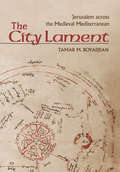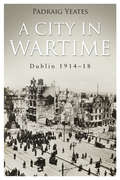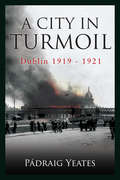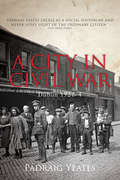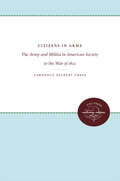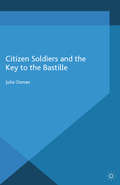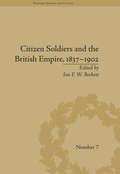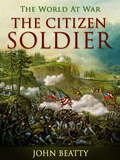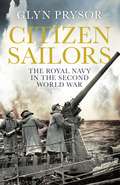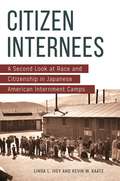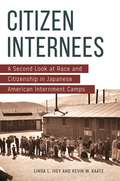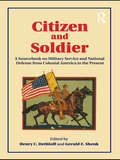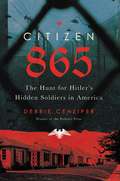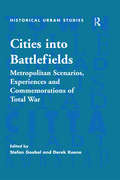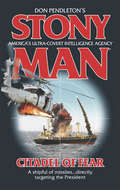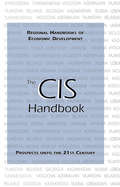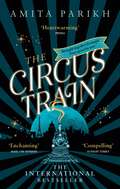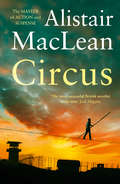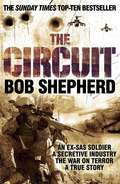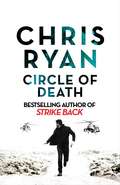- Table View
- List View
The City Lament: Jerusalem across the Medieval Mediterranean
by Tamar M. BoyadjianPoetic elegies for lost or fallen cities are seemingly as old as cities themselves. In the Judeo-Christian tradition, this genre finds its purest expression in the book of Lamentations, which mourns the destruction of Jerusalem; in Arabic, this genre is known as the ritha al-mudun. In The City Lament, Tamar M. Boyadjian traces the trajectory of the genre across the Mediterranean world during the period commonly referred to as the early Crusades (1095–1191), focusing on elegies and other expressions of loss that address the spiritual and strategic objective of those wars: Jerusalem. Through readings of city laments in English, French, Latin, Arabic, and Armenian literary traditions, Boyadjian challenges hegemonic and entrenched approaches to the study of medieval literature and the Crusades.The City Lament exposes significant literary intersections between Latin Christendom, the Islamic caliphates of the Middle East, and the Armenian kingdom of Cilicia, arguing for shared poetic and rhetorical modes. Reframing our understanding of literary sources produced across the medieval Mediterranean from an antagonistic, orientalist model to an analogous one, Boyadjian demonstrates how lamentations about the loss of Jerusalem, whether to Muslim or Christian forces, reveal fascinating parallels and rich, cross-cultural exchanges.
A City in Wartime – Dublin 1914–1918: The Easter Rising 1916 (New Perspectives On Modern Jewish History Ser. #1)
by Pádraig YeatesThis fascinating history looks at how the lives of ordinary Dubliners were affected by these three major events Why did so many working-class Dublin men join the British Army? How did the city’s 92,000 Protestants fare in this turbulent time? Dubliners fought on both sides in the Easter Rising. What were their motivations? How did Sinn Féin and the Catholic Church marginalise Labour in the battle for political control of the city after the Rising? Why did so many Dubliners benefit from the British war effort, especially tenement families and working women? Pádraig Yeates discusses each of these in detail and also looks at how the population fed itself during hard times, the impact of the war on music halls, child cruelty, prostitution, public health and much more. The Dublin as we know it was shaped in these years. And this captivating book takes you back to those times to shine a new light on the city today.
A City in Turmoil – Dublin 1919–1921: The War of Independence
by Padraig YeatesDublin was the cockpit of the Irish Revolution. It was in the capital that Dáil Éireann convened and built an alternative government to challenge the authority of Dublin Castle; it was where the munitions strike that crippled the British war effort in 1920 began and it was where rival intelligence organisations played out their deadly game of cat and mouse. But it was also a city where ambushes became a daily occurrence and ordinary civilians were caught in the deadly crossfire. Restrictions on travel, military curfews and the threat of internment would ultimately make normal life impossible.As in his previous work, A City in Wartime, Pádraig Yeates uncovers unknown and neglected aspects of the Irish Revolution, including the role that the Bank of Ireland played in keeping the city solvent, the rise of the Municipal Reform Association to challenge the hegemony of Sinn Féin and Labour, how one of Ireland's leading businessmen started out as a bagman for Michael Collins and how, ultimately, many Dubliners found it easier to sympathise with the fight for the Republic than participate in or pay for it.
A City in Civil War – Dublin 1921–1924: The Irish Civil War
by Padraig YeatesThe long-awaited concluding volume of Pádraig Yeates’ ‘Dublin at War’ trilogyIn A City in Civil War: Dublin 1921–1924, acclaimed historian Pádraig Yeates turns his attention to Ireland’s bloody and hard-fought Civil War and its impact on the capital city and its inhabitants.The fascinating A City in Civil War tells the story of Dublin’s troubled passage to independence amidst the acrimony and upheaval of the Civil War, a period in which Dublin became the capital city of an independent Irish state for the first time.Once again, conflict raged on Dublin’s streets, but this time the combatants were Irishmen – neighbours, friends, families – fighting each other. For a great many Dubliners, life remained a cycle of grinding poverty, but for many southern Unionists, ex-servicemen and anti-Treaty republicans, the city became a hostile environment. And all the while, the Catholic Church strengthened its grip on Irish cultural life, supplying many of the vital social services an embattled government was too poor and too preoccupied to provide its citizens.In his distinctive and engaging style, Pádraig Yeates uncovers unknown and neglected aspects of the Irish Civil War in the capital and their impact on the rest of the country.‘Pádraig Yeates excels as a social historian and never loses sight of the ordinary citizen.’The Irish Times ‘A powerful social history … reminds us that for all the headline grabbing events, putting bread on the table was still the most important priority for most’Professor Diarmaid Ferriter, The Irish Independent‘Reminds the reader of how daily life went on side by side with the great events of history. In short, this is an excellent addition to the current literature.’Irish Literary Supplement
Citizens in Arms: The Army and Militia in American Society to the War of 1812
by Lawrence Delbert CressThis first study to discuss the important ideological role of the military in the early political life of the nation examines the relationship between revolutionary doctrine and the practical considerations of military planning before and after the American Revolution. Americans wanted and effective army, but they realized that by its very nature the military could destroy freedom as well as preserve it. The security of the new nation was not in dispute but the nature of republicanism itself.Originally published 1982. A UNC Press Enduring Edition -- UNC Press Enduring Editions use the latest in digital technology to make available again books from our distinguished backlist that were previously out of print. These editions are published unaltered from the original, and are presented in affordable paperback formats, bringing readers both historical and cultural value.
Citizen Soldiers and the Key to the Bastille (War, Culture and Society, 1750-1850)
by Julia OsmanShowcasing French participation in the Seven Years' War and the American Revolution, this book shows the French army at the heart of revolutionary, social, and cultural change. Osman argues that efforts to transform the French army into a citizen army before 1789 prompted and helped shape the French Revolution.
Citizen Soldiers and the British Empire, 1837–1902 (Warfare, Society and Culture)
by Ian F BeckettThe British amateur military tradition of raising auxiliary forces for home defence long preceded the establishment of a standing army. This was a model that was widely emulated in British colonies. This volume of essays seeks to examine the role of citizen soldiers in Britain and its empire during the Victorian period.
Citizen Soldiers and the British Empire, 1837–1902 (Warfare, Society and Culture #7)
by Ian F BeckettThe British amateur military tradition of raising auxiliary forces for home defence long preceded the establishment of a standing army. This was a model that was widely emulated in British colonies. This volume of essays seeks to examine the role of citizen soldiers in Britain and its empire during the Victorian period.
The Citizen-Soldier: Or; Memoirs Of A Volunteer (The World At War)
by John BeattyJohn Beatty (December 16, 1828 – December 4, 1914) was an American banker and statesman from Sandusky, Ohio. He served as a brigadier general in the Union Army during the American Civil War. (Excerpt from Wikipedia)
Citizen Sailors: The Royal Navy in the Second World War
by Glyn Prysor'The deck and the bridge were pointing to the sky at an alarming angle and our thoughts were to get the devil out of it and into the water. Almost in unison we shouted "for God's sake jump boys".'Citizen Sailors is a groundbreaking people's history of the Royal Navy in the Second World War. Drawing on hundreds of contemporary diaries and letters, along with memoirs, oral history and official documents, Glyn Prysor tells the human story of Britain's war at sea.The sailors of the Royal Navy fought from the very first day of the war until the very last. They played a vital part in a truly global war, from America to Australia and from the Arctic to South Africa. They fought in every conceivable vessel: vast aircraft carriers and cramped corvettes, fast motor boats and rickety minesweepers, Swordfish biplanes and ageing submarines. Seen through the eyes of sailors themselves, this is a compelling account of life in the wartime Royal Navy: humanity and horror, triumphs and tragedies, nerve-wracking convoys and epic gun battles, devastating aerial bombardment and swashbuckling amphibious landings. Citizen Sailors puts the Royal Navy and its sailors back at the heart of the story of Britain's Second World War.
Citizen Internees: A Second Look at Race and Citizenship in Japanese American Internment Camps
by Linda L. Ivey Kevin W. KaatzThrough a new collection of primary documents about Japanese internment during World War II, this book enables a broader understanding of the injustice experienced by displaced people within the United States in the 20th century.In the 1940s, Japanese and Japanese American internees of Redwood City, CA, had a dedicated ally: J. Elmer Morrish, a banker who kept their businesses alive, made sure their taxes were paid, and safeguarded their properties until after the end of World War II and the internees were finally released. What were Morrish's motivations for his tireless efforts to help the internees? How did the unjustly incarcerated deal with the loss of freedom in the camps, and how did they envision their future? And how did the internees both cooperate with the U.S. government and attempt to resist victimization?Citizen Internees: A Second Look at Race and Citizenship in Japanese American Internment Camps is an edited selection from a collection of more than 2,000 pieces of correspondence—some of which is previously unpublished—regarding the internment of Japanese and Japanese Americans from Redwood City, CA. These primary source documents reveal the experiences and emotions of a group of imprisoned people attempting to run the necessary day-to-day tasks of the lives they were forced to leave behind—as property owners, taxpayers, and proprietors. Through these letters about practical matters, readers can gain insight into the internees' changing family relations, their financial concerns, and their struggles in making decisions about an uncertain future. The book also includes essays that supply background information, analysis of the documents' contents and meaning, and historical context.
Citizen Internees: A Second Look at Race and Citizenship in Japanese American Internment Camps
by Linda L. Ivey Kevin W. KaatzThrough a new collection of primary documents about Japanese internment during World War II, this book enables a broader understanding of the injustice experienced by displaced people within the United States in the 20th century.In the 1940s, Japanese and Japanese American internees of Redwood City, CA, had a dedicated ally: J. Elmer Morrish, a banker who kept their businesses alive, made sure their taxes were paid, and safeguarded their properties until after the end of World War II and the internees were finally released. What were Morrish's motivations for his tireless efforts to help the internees? How did the unjustly incarcerated deal with the loss of freedom in the camps, and how did they envision their future? And how did the internees both cooperate with the U.S. government and attempt to resist victimization?Citizen Internees: A Second Look at Race and Citizenship in Japanese American Internment Camps is an edited selection from a collection of more than 2,000 pieces of correspondence—some of which is previously unpublished—regarding the internment of Japanese and Japanese Americans from Redwood City, CA. These primary source documents reveal the experiences and emotions of a group of imprisoned people attempting to run the necessary day-to-day tasks of the lives they were forced to leave behind—as property owners, taxpayers, and proprietors. Through these letters about practical matters, readers can gain insight into the internees' changing family relations, their financial concerns, and their struggles in making decisions about an uncertain future. The book also includes essays that supply background information, analysis of the documents' contents and meaning, and historical context.
Citizen and Soldier: A Sourcebook on Military Service and National Defense from Colonial America to the Present
by Henry C. Dethloff Gerald E. ShenkAmericans grow up expecting that in a time of need, their country can depend on its people for volunteer service to the military. Indeed, this has been a social and at times legal expectation for the citizenship of this country since 1776. Yet, since the end of World War II United States forces have been caught up in many long term military engagements, and the military aspect of citizenship has become an increasingly marginalized one in a world where only a minority of citizens even vote. Citizen and Soldier: A Sourcebook on Military Service and National Defense from Colonial America to the Present provides a useful framework and supporting documentary evidence for an informed discussion of the development of the American ideal of the "Citizen Soldier". Presented with insightful introductions and useful discussion questions, this concise collection of 27 primary documents takes a close look at the United States military and shows how it became entwined with the rise of American national identity.
Citizen and Soldier: A Sourcebook on Military Service and National Defense from Colonial America to the Present
by Henry C. Dethloff Gerald E. ShenkAmericans grow up expecting that in a time of need, their country can depend on its people for volunteer service to the military. Indeed, this has been a social and at times legal expectation for the citizenship of this country since 1776. Yet, since the end of World War II United States forces have been caught up in many long term military engagements, and the military aspect of citizenship has become an increasingly marginalized one in a world where only a minority of citizens even vote. Citizen and Soldier: A Sourcebook on Military Service and National Defense from Colonial America to the Present provides a useful framework and supporting documentary evidence for an informed discussion of the development of the American ideal of the "Citizen Soldier". Presented with insightful introductions and useful discussion questions, this concise collection of 27 primary documents takes a close look at the United States military and shows how it became entwined with the rise of American national identity.
Citizen 865: The Hunt for Hitler's Hidden Soldiers in America
by Debbie CenziperThe gripping story of a team of Nazi hunters at the U.S. Department of Justice as they raced against time to expose members of a brutal SS killing force who disappeared in America after World War Two.In 1990, in a drafty basement archive in Prague, two American historians made a startling discovery: a Nazi roster from 1945 that no Western investigator had ever seen. The long-forgotten document, containing more than 700 names, helped unravel the details behind the most lethal killing operation in World War Two. In the tiny Polish village of Trawniki, the SS set up a school for mass murder and then recruited a roving army of foot soldiers, 5,000 men strong, to help annihilate the Jewish population of occupied Poland. After the war, some of these men vanished, making their way to the U.S. and blending into communities across America. Though they participated in some of the most unspeakable crimes of the Holocaust, "Trawniki Men" spent years hiding in plain sight, their terrible secrets intact.In a story spanning seven decades, Citizen 865 chronicles the harrowing wartime journeys of two Jewish orphans from occupied Poland who outran the men of Trawniki and settled in the United States, only to learn that some of their one-time captors had followed. A tenacious team of prosecutors and historians pursued these men and, up against the forces of time and political opposition, battled to the present day to remove them from U.S. soil. Through insider accounts and research in four countries, this urgent and powerful narrative provides a front row seat to the dramatic turn of events that allowed a small group of American Nazi hunters to hold murderous men accountable for their crimes decades after the war's end.
Citizen 865: The Hunt for Hitler's Hidden Soldiers in America
by Debbie Cenziper**Investigative Reporters and Editors (IRE) Book Award Finalist**The gripping story of a team of Nazi hunters at the U.S. Department of Justice as they raced against time to expose members of a brutal SS killing force who disappeared in America after World War Two.In 1990, in a drafty basement archive in Prague, two American historians made a startling discovery: a Nazi roster from 1945 that no Western investigator had ever seen. The long-forgotten document, containing more than 700 names, helped unravel the details behind the most lethal killing operation in World War Two. In the tiny Polish village of Trawniki, the SS set up a school for mass murder and then recruited a roving army of foot soldiers, 5,000 men strong, to help annihilate the Jewish population of occupied Poland. After the war, some of these men vanished, making their way to the U.S. and blending into communities across America. Though they participated in some of the most unspeakable crimes of the Holocaust, "Trawniki Men" spent years hiding in plain sight, their terrible secrets intact.In a story spanning seven decades, Citizen 865 chronicles the harrowing wartime journeys of two Jewish orphans from occupied Poland who outran the men of Trawniki and settled in the United States, only to learn that some of their one-time captors had followed. A tenacious team of prosecutors and historians pursued these men and, up against the forces of time and political opposition, battled to the present day to remove them from U.S. soil. Through insider accounts and research in four countries, this urgent and powerful narrative provides a front row seat to the dramatic turn of events that allowed a small group of American Nazi hunters to hold murderous men accountable for their crimes decades after the war's end.
Cities into Battlefields: Metropolitan Scenarios, Experiences and Commemorations of Total War (Historical Urban Studies Series)
by Stefan GoebelCities have always had a key role in warfare, as strategic centres which periodically suffered the horrors of siege and sack. With industrialisation, however, they were drawn ever closer to the front line and to direct and continuous experience of fighting and destruction. 'Cities into Battlefields: Metropolitan Scenarios, Experiences and Commemorations of Total War' explores the cultural imprint of military conflict on metropolises world wide in the era of the First and Second World Wars. It brings together cultural and urban historians and scholars of related disciplines including anthropology, education, and geography. The volume examines how the emergence of 'total' warfare blurred the boundaries between home and front and transformed cities into battlefields. The logic of total mobilisation turned the social and cultural fabric of urban life upside down. Arranged so as to bring out the evolution of experience over time, the essays explore Eastern and Central Europe, Britain and Western Europe, and Japan and address several key themes. The first strand - scenarios - explores the apocalyptic imagination of intellectuals and experts in peacetime. Artists and writers anticipating doom presented the coming upheaval as an urban event - a commonplace of late-Victorian and post-1918 pessimism. On a different plane, civil servants and engineers materialised visions of urban chaos and devised countermeasures in case of emergencies. Both groups helped to furnish a repertoire of cultural forms which channelled and encoded the actual experience of war. The second strand deals with metropolitan experiences, notably mobilisation, deprivation, and destruction in wartime. Ruins and the repercussions of war is the central theme of the third strand - commemorations - which investigates post-war efforts to remember and forget. The quest for meaningful forms of commemoration was hard enough after the First World War; the Second World War, which saw whole cities disappear in flames, raised the possibility that the limits of representation had been reached. The central contention of this volume - that total war in the twentieth century has a significant but often overlooked metropolitan dimension - is fully addressed, thereby filling a conspicuous gap in the currently available literature.
Cities into Battlefields: Metropolitan Scenarios, Experiences and Commemorations of Total War (Historical Urban Studies Series)
by Stefan GoebelCities have always had a key role in warfare, as strategic centres which periodically suffered the horrors of siege and sack. With industrialisation, however, they were drawn ever closer to the front line and to direct and continuous experience of fighting and destruction. 'Cities into Battlefields: Metropolitan Scenarios, Experiences and Commemorations of Total War' explores the cultural imprint of military conflict on metropolises world wide in the era of the First and Second World Wars. It brings together cultural and urban historians and scholars of related disciplines including anthropology, education, and geography. The volume examines how the emergence of 'total' warfare blurred the boundaries between home and front and transformed cities into battlefields. The logic of total mobilisation turned the social and cultural fabric of urban life upside down. Arranged so as to bring out the evolution of experience over time, the essays explore Eastern and Central Europe, Britain and Western Europe, and Japan and address several key themes. The first strand - scenarios - explores the apocalyptic imagination of intellectuals and experts in peacetime. Artists and writers anticipating doom presented the coming upheaval as an urban event - a commonplace of late-Victorian and post-1918 pessimism. On a different plane, civil servants and engineers materialised visions of urban chaos and devised countermeasures in case of emergencies. Both groups helped to furnish a repertoire of cultural forms which channelled and encoded the actual experience of war. The second strand deals with metropolitan experiences, notably mobilisation, deprivation, and destruction in wartime. Ruins and the repercussions of war is the central theme of the third strand - commemorations - which investigates post-war efforts to remember and forget. The quest for meaningful forms of commemoration was hard enough after the First World War; the Second World War, which saw whole cities disappear in flames, raised the possibility that the limits of representation had been reached. The central contention of this volume - that total war in the twentieth century has a significant but often overlooked metropolitan dimension - is fully addressed, thereby filling a conspicuous gap in the currently available literature.
Citadel Of Fear
by Don PendletonSTONY MAN America's elite black ops team Stony Man Farm is dedicated to protecting the innocent. Acting on orders of the President, these soldiers and cyber techs are the nation's best defense against violence and terror across the globe.
The CIS Handbook (Regional Handbooks of Economic Development)
by Patrick Heenan Monique LamontagneFirst Published in 2000. Routledge is an imprint of Taylor & Francis, an informa company.
The CIS Handbook (Regional Handbooks of Economic Development #Vol. 4)
by Patrick Heenan Monique Lamontagne Ronald J. Hill Bogdan SzajkowskiFirst Published in 2000. Routledge is an imprint of Taylor & Francis, an informa company.
The Circus Train: The entrancing, magical international bestseller
by Amita ParikhTHE MAGICAL INTERNATIONAL BESTSELLER Brought together by magic. Torn apart by war. 'DAZZLING' Ellen Keith 'SUPERB' Reader Review (5 stars) 'EXTRAORDINARY' Kristin Harmel'PHENOMENAL' Reader Review (5 stars)'CAPTIVATING' Constance Sayers 'MESMERIZING' Reader Review (5 stars)'SPELLBINDING' Carol Windley _________Europe, 1938. Even as the daughter of the extraordinary headlining illusionist, Lena Papadopoulos has never quite found her place within the World of Wonders - a travelling circus that traverses the continent in a luxury steam engine. Brilliant and curious, Lena yearns for the real-world magic of science and medicine, despite the limitations she feels in her wheelchair. But when a young French orphan, Alexandre, comes aboard the circus train, Lena's life is infused with magic and wonder for the first time.But outside the bright lights of the circus, darkness is descending on Europe. War is about to shatter Lena's world, and take away everything she holds dear. And to recover what she has lost, Lena will have to believe in the impossible. A must-read for fans of Water for Elephants, The Circus Train will take readers on a heart-wrenching two-decade journey across a continent in which great beauty and unimaginable horror live side by side. _________'BEAUTIFUL' Reader Review (5 stars)'POWERFUL' Pam Jenoff 'DELIGHTFUL' Reader Review (5 stars) 'TRIUMPHANT' Lorelei Savaryn'EXQUISITE' Reader Review (5 stars)
Circus: A Circus Family Tames The West
by Alistair MacLeanReissue of the classic tale of espionage set in Cold War Europe, where the world’s greatest circus acrobat must break into an impenetrable fortress, from the acclaimed master of action and suspense.
The Circuit: An Ex-sas Soldier - A Secretive Industry - The War On Terror - A True Story (The Pan Real Lives Series #2)
by Bob ShepherdAfter nearly 20 years of SAS operations, including a never before published role in the infamous Bravo Two Zero patrol, Bob retired from the military to work as an advisor on the international commercial security circuit. Certain his most dangerous days were behind him, Bob settled into a sedate life looking after VIPs. Then 9/11 happened. Bob found himself back in war zones on assignments far more perilous than anything he had encountered in the SAS: from ferrying journalists across firing lines in The West Bank and Gaza to travelling to the heart of Osama bin Laden’s Afghan lair. As part of a two-man team, Bob searched for ITN Correspondent Terry Lloyd’s missing crew in Basra, Iraq, while in Afghanistan he was forced to spend the night as the only Westerner in Khost – with a $25,000 bounty on his head. As the War on Terror escalated, Bob contended with increasingly sophisticated insurgents. But the most disturbing development he witnessed was much closer to home: The Circuit’s rise from a niche business staffed by top veterans into an unregulated, billion dollar industry that too often places profits above lives. This is a pulse-racing and at times shocking testament to what is really happening, on the ground, in the major trouble spots of the world.
Circle of Death: A Strike Back Novel (5)
by Chris Ryan'Ryan never fails to nail the target with a well-aimed burst of rapid-fire realism.' - Crime ReviewEx-SAS heroes Bald and Porter take on the Deep State in the nail-shredding new Strike Back thrillerIn a world run by rich and powerful men, Julian Cantwell is more powerful than most. A ruthless political consultant, Cantwell has manipulated elections around the world, bribing opponents and blackmailing political rivals. Doing whatever it takes for his clients to win. But when a freelance journalist threatens to expose his alleged involvement in a terrifying conspiracy, Cantwell suddenly finds himself under threat. Backed into a corner, he is forced to take drastic action. Meanwhile in London, former Regiment hero John Porter and ex-SAS vagabond John Bald are drafted in by their MI6 paymasters for a highly secretive - and dangerous - mission. A respected British academic has been arrested in chaos-stricken Venezuela. Accused of spying for the British government, she is being held captive by the President's notorious security forces. Working alongside a team of ex-Navy SEALs, Bald and Porter are tasked with infiltrating Venezuela and rescuing the academic before she caves in to her interrogators. But as they get closer to their target, Bald and Porter begin to uncover a terrifying plot. A conspiracy that goes right to the very heart of power. To survive, they must face down their deadliest enemy yet, in a desperate fight to the death. In the battle between the SAS and the Navy SEALs there can be only one winner. Will Bald and Porter prevail? Or have our heroes finally met their match?
